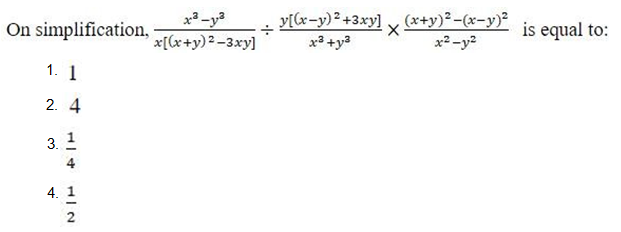Question
Which of the following pair of symbols will define the
relation between Quantity I and Quantity II Quantity 1: A and B together can complete a task in 15 days. B and C together can complete it in 20 days. A and C together can complete it in 30 days. How long will A, B, and C together take to complete the task? Quantity 2: A, B, and C can individually complete the task in 24, 36, and 48 days respectively. How long will they take to complete the task together?Solution
For Quantity 1: Let total work be 60 units (LCM of 15, 20, 30). A + B’s 1 day work = 60/15 = 4 units B + C’s 1 day work = 60/20 = 3 units A + C’s 1 day work = 60/30 = 2 units Adding all: 2(A + B + C) = 4 + 3 + 2 = 9 ⟹ A + B + C = 4.5 units/day Total time taken = 60/4.5 = 13.33 days Quantity 1 = 13.33 days For Quantity 2: A’s 1 day work = 1/24, B’s 1 day work = 1/36, C’s 1 day work = 1/48 Total 1 day work = 1/24 + 1/36 + 1/48 = (6 + 4 + 3)/144 = 13/144 Total time = 144/13 = 11.08 days Quantity 2 = 11.08 days Correct option: a) Quantity 1 > Quantity 2
If p = 24 - q - r and pq + r(q + p) = 132, then find the value of (p² + q² + r²).
((99.9 - 20.9)² + (99.9 + 20.9)² )/(99.9 x 99.9 + 20.9 x 20.9) = ?
...
Find the value of the given expression-
(4x+4 -5× 4x+2) / 15×4x – 22×4x
If 4x² + y² = 40 and x y = 6, then find the value
of 2x + y?
If p = 40 - q - r and pq + r(q + p) = 432, then find the value of (p² + q² + r²).
47.98 × 4.16 + √325 × 12.91 + ? = 79.93 × 5.91
If x + y = 4 and (1/x) + (1/y) = 24/7, then the value of (x3 + y3).
- If p = 20 - q - r and pq + r(p + q) = 154, then find the value of (p² + q² + r²).
If a = (√2 - 1)1/3, then the value of (a-1/a)3 +3(a-1/a) is:


